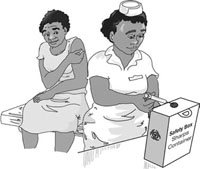6.3 Infection prevention procedure
When carrying out any procedure, it is important to prevent the spread of infection by using proper infection prevention procedures. Microorganisms live everywhere in our environment. We normally carry them on our skin and in our bodies. Microorganisms are also found in animals, plants, soil, air and water. Some of these microorganisms can cause infections. Therefore, when you perform any procedure, it is very important to follow the principles of infection prevention precautions detailed in Box 6.3.
Box 6.3 Infection prevention precautions
- Create an infection-free environment by making it very clean, and avoiding the use of unclean materials.
- Handle all items from all clients as if they are contaminated.
- Use barriers such as gloves that serve to break the disease transmission cycle (see your Communicable Diseases Module).
- All disposable materials, such as gloves, syringes and needles, should be discarded into a safety box (Figure 6.9).

When you carry out any invasive procedure, you have to wash your hands thoroughly using water and ordinary soap. You must wear gloves during implant insertion to prevent the transmission of infection. It is mandatory to use an antiseptic, for example Savlon, alcohol or iodine solution, for cleaning wounds or the skin prior to the implant insertion procedure.
6.2.4 Implanon
